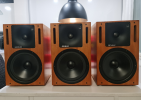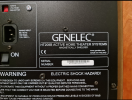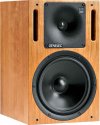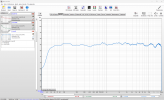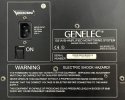How peaceful can anything really be when surrounded by the Dutch?Comparing it to the last two speakers measured by Amir, it's like driving in the Netherlands vs that city in US we see in car chase movies (is it LA or San Francisco?).
-
Welcome to ASR. There are many reviews of audio hardware and expert members to help answer your questions. Click here to have your audio equipment measured for free!
You are using an out of date browser. It may not display this or other websites correctly.
You should upgrade or use an alternative browser.
You should upgrade or use an alternative browser.
Genelec 1031A Measurements & Review
- Thread starter Nuyes
- Start date
-
- Tags
- genelec genelec 1031a
Waxx
Major Contributor
I think the difference in general "monitor" quality between Genelec and Neumann monitors is mainly subjective. They are both very neutral and revealing speakers, top of their league. I prefer Neumann because the Genelecs are hard for my ears. Others prefer the Genelecs. But there is not an objective factor that makes one better than the other as far as I know, only subjective ones.
That's interesting cause I started with speaker building that time and really wanted to build a big and (for me in that age) expensive speaker with Seas tweeter. But after listening ... I went to ScanSpeak. I didn't like all the standard metal dome speakers from this time (I even owned 2 for monitoring and listened for some time). They all add to much >10kHz for me and work out details to obvious.I heared these metal domes from seas in other speakers also, and there it's not an issue. Genelec does use the Seas H1124-06 25TAFD/GW-G tweeter in this speaker, the same that is used in the Harbeth HL5+, and that is a speaker i can listen to for hours.
But even Speakers like the Grimm use them and get good references - so it doesn't seem impossible to tame this tweeters. (but I never heared the Grimms and the new Version actually has a Beryllium tweeter).
I can imagine that the KH310 is to dull when you are used to an old Genelec
Waxx
Major Contributor
The Neumann tweeter is also a metal tweeter in a certain way, it's a combination of a thin alloy film on a fabric dome that they use. But the sound is much softer than most metal tweeters, more like a soft dome i think. As far as i heared it's a custom design, made by an OEM company to specifications by Neumann.
Genelec used in this speaker a customised verson of the Seas 25TAFD tweeter that was availeble (now out of production) for diy crowd also. It's not exact the same as the one Genelec uses, but a variation of it with minor differences. This is the spec sheet of the one that was public availeble:
Genelec used in this speaker a customised verson of the Seas 25TAFD tweeter that was availeble (now out of production) for diy crowd also. It's not exact the same as the one Genelec uses, but a variation of it with minor differences. This is the spec sheet of the one that was public availeble:
That's not so much the tweeter materials (though yes, it's a metal dome with a fabric layer; it knocks down the breakup modes) as it is the off-axis response, which is markedly narrower than on most Genelecs. Even in a treated room, that will make a difference.The Neumann tweeter is also a metal tweeter in a certain way, it's a combination of a thin alloy film on a fabric dome that they use. But the sound is much softer than most metal tweeters, more like a soft dome i think.
There's something odd on the 95dB SPL graph: we see 3rd harmonic about 10dB below the fundamental in ~50Hz range, which should translate into ~25% + THD, but the graph below that shows 3.5% max?
Interesting, I did measure the similar THD issue in the lows on the KH310 in #1,089 , as also reported by Amir in same thread.
Even in near field there should be a performance hit from this distortion I believe.
Interesting, I did measure the similar THD issue in the lows on the KH310 in #1,089 , as also reported by Amir in same thread.
Even in near field there should be a performance hit from this distortion I believe.
Last edited:
Hellasärö
Member
- Joined
- Sep 9, 2022
- Messages
- 54
- Likes
- 96
I bought three HT208B, which is the same as the 1031, I think?
Very nice looking in cherry finish. I wish Genelec made their big 3-ways in this finish, I'd buy one in a heartbeat.
Very nice looking in cherry finish. I wish Genelec made their big 3-ways in this finish, I'd buy one in a heartbeat.
Attachments
That chart is misleading as it's weighted via a psychoacoustic model.There's something odd on the 95dB SPL graph: we see 3rd harmonic about 10dB below the fundamental in ~50Hz range, which should translate into ~25% + THD, but the graph below that shows 3.5% max?
Interesting, I did measure the similar THD issue in the lows on the KH310 in #1,089 , as also reported by Amir in same thread.
Even in near field there should be a performance hit from this distortion I believe.
norman bates
Senior Member
Can you buy a swap in amplifier/crossover module for when it gives up the ghost ?
Seems many are not impressed with longevity of some amplified speakers.............
Seems many are not impressed with longevity of some amplified speakers.............
RobL
Major Contributor
- Joined
- Mar 4, 2021
- Messages
- 1,029
- Likes
- 1,781
I’d imagine Genelec still services 1031’s…they even recently rebuilt a pair of S45YA’s (Yamaha NS1000’s made active/triamped by Genelec~1978) for a customer on the Genelec Facebook page.Can you buy a swap in amplifier/crossover module for when it gives up the ghost ?
Seems many are not impressed with longevity of some amplified speakers.............
These went out of production nearly 20 years ago and are still commonplace in studios. That's pretty good longevity, I'd say.Seems many are not impressed with longevity of some amplified speakers.............
Waxx
Major Contributor
Genelec is one of the few that still service their very old models. And mostly they still got parts left to do that. But many brands of active speakers don't, and that is a big issue.
Moi, have you asked for a custom finish from Genelec? They are quite flexible when it comes to customer service, especially in the price range of the Master series speakers. https://support.genelec.com/hc/en-us/articles/360017799019-Can-I-buy-Genelec-in-different-color-I wish Genelec made their big 3-ways in this finish, I'd buy one in a heartbeat.
beagleman
Major Contributor
I mean, great in some ways, but looking closer at that response, which is amazingly flat.
Wonder if it will sound "thin", as good bits of the upper midrange/treble ((2.5 Khz-8Khz)) are about 1.5-2 db or so higher than the lower bands.
Wonder if it will sound "thin", as good bits of the upper midrange/treble ((2.5 Khz-8Khz)) are about 1.5-2 db or so higher than the lower bands.
- Thread Starter
- #55
added ---- 07-12-2023 ----In fact, there's something I haven't shared with you all. It's a behind-the-scenes story about this speaker measurement.
First, could you please take a look at this data?
View attachment 329749View attachment 329750View attachment 329751
(Blue represents before repair, and red represents after repair.)
After completing the measurements and organizing the data, I was shocked. There was a dip around the frequency I assumed to be the crossover point.
Based on the test results, I was convinced that the units' polarity might have been assembled in reverse. I contacted the owner of the speaker and got permission to disassemble it.
Upon disassembling and testing the speaker, I discovered that the tweeter was indeed assembled with reversed polarity. However, there were no separate polarity markings on the post side of both the tweeter and woofer, and the post standards were the same. Therefore, I believe it was a mistake that could easily have occurred on the production line.
added ---- 07-12-2023 ----
I have been in communication with a technical expert from Genelec, who thoroughly investigated this speaker sample and informed me about it.
Since he will provide detailed data and explanations, I will only share the conclusion.
In conclusion, the Genelec 1031A sample I measured was originally shipped in proper condition by the manufacturer. It is speculated that the polarity of the tweeter was altered during disassembly and reassembly, either by the importer or a private repair service.
The cabling was done so meticulously and bonded so well that even I was deceived..
I apologize for any confusion caused.
I have been in communication with a technical expert from Genelec, who thoroughly investigated this speaker sample and informed me about it.
Since he will provide detailed data and explanations, I will only share the conclusion.
In conclusion, the Genelec 1031A sample I measured was originally shipped in proper condition by the manufacturer. It is speculated that the polarity of the tweeter was altered during disassembly and reassembly, either by the importer or a private repair service.
The cabling was done so meticulously and bonded so well that even I was deceived..
I apologize for any confusion caused.
RobL
Major Contributor
- Joined
- Mar 4, 2021
- Messages
- 1,029
- Likes
- 1,781
The perils of testing speakers that have been out in the wild for a couple of decades. Thanks for the follow up!added ---- 07-12-2023 ----
I have been in communication with a technical expert from Genelec, who thoroughly investigated this speaker sample and informed me about it.
Since he will provide detailed data and explanations, I will only share the conclusion.
In conclusion, the Genelec 1031A sample I measured was originally shipped in proper condition by the manufacturer. It is speculated that the polarity of the tweeter was altered during disassembly and reassembly, either by the importer or a private repair service.
The cabling was done so meticulously and bonded so well that even I was deceived..
I apologize for any confusion caused.
It would be very unusual for that mistake to get through Genelec QC, as speakers are individually calibrated on the line.
I have been in communication with a technical expert from Genelec, who thoroughly investigated this speaker sample and informed me about it.
Since he will provide detailed data and explanations, I will only share the conclusion.
Hi all,
This thread was brought up to my knowledge by a colleague here at Genelec. It was obvious to us that the tweeter polarity issue and the resulted bad frequency response could not have passed our production quality check, but I needed to dig up some old data to be able to prove it. I sent PM to Nuyes and asked about the serial number of the unit which he kindly provided. From there I could find out that the speaker was manufactured in June 2002. Luckily we have stored all production quality check data for quite some time and I was able to find the files for this specific unit (production number: 021002_120_045, MLSSA measurement data file: 60029783). There we can see that the frequency response of this 1031A with a serial number of M6112910 is perfectly normal and does not exhibit a large attenuation at the crossover frequency. From there we can conclude that the said speaker was in perfect condition once it was shipped out from the factory in July 18th 2002. From there on we can't be sure what has happened to it but it looks like for some reason the speaker has been opened up and the tweeter wires have been connected the wrong way, causing wrong polarity and the resulting large attenuation at the crossover frequency. In the tweeter unit the positive terminal is usually marked with red colour and with a "+" sign molded into the plastic faceplate, helping the person installing the wires to connect them right. Wires are typically marked with red and white colour for the tweeter.
Attachments
Rhubarb
Member
Well, this cements my thinking that my next (and last) set of apeakers should be Genelecs. This is how businesses should be run. And life lived! For the long haul, with a desire and responsibility to make things of value to living, that last and we can hand down through time. Thank you, Illka, and Genelec workers, from the bottom of my heart.Hi all,
This thread was brought up to my knowledge by a colleague here at Genelec. It was obvious to us that the tweeter polarity issue and the resulted bad frequency response could not have passed our production quality check, but I needed to dig up some old data to be able to prove it. I sent PM to Nuyes and asked about the serial number of the unit which he kindly provided. From there I could find out that the speaker was manufactured in June 2002. Luckily we have stored all production quality check data for quite some time and I was able to find the files for this specific unit (production number: 021002_120_045, MLSSA measurement data file: 60029783). There we can see that the frequency response of this 1031A with a serial number of M6112910 is perfectly normal and does not exhibit a large attenuation at the crossover frequency. From there we can conclude that the said speaker was in perfect condition once it was shipped out from the factory in July 18th 2002. From there on we can't be sure what has happened to it but it looks like for some reason the speaker has been opened up and the tweeter wires have been connected the wrong way, causing wrong polarity and the resulting large attenuation at the crossover frequency. In the tweeter unit the positive terminal is usually marked with red colour and with a "+" sign molded into the plastic faceplate, helping the person installing the wires to connect them right. Wires are typically marked with red and white colour for the tweeter.
itisljar
New Member
- Joined
- Oct 29, 2017
- Messages
- 4
- Likes
- 5
Hello all!
I'm a long time lurker, I do have an account, but not posting much. I'd like to share my experience, I have these at home as main system speakers. I got them as a gift many years ago, and they are connected to some unknown brand small preamp, I guess from late 70's or early 80's. Preamp does not give full voltage line out, and I am aware of that - but they sound really good, and what's more important, my wife likes their sound. I don't get fatigue listening to them, in fact, i really like their sound. They sound clean, I've configured them according to manual, and happily listening to music, watching movies and shows.
Thank you for measurements, @Nuyes .
I'm a long time lurker, I do have an account, but not posting much. I'd like to share my experience, I have these at home as main system speakers. I got them as a gift many years ago, and they are connected to some unknown brand small preamp, I guess from late 70's or early 80's. Preamp does not give full voltage line out, and I am aware of that - but they sound really good, and what's more important, my wife likes their sound. I don't get fatigue listening to them, in fact, i really like their sound. They sound clean, I've configured them according to manual, and happily listening to music, watching movies and shows.
Thank you for measurements, @Nuyes .
Last edited:
Similar threads
- Poll
- Replies
- 66
- Views
- 15K
- Poll
- Replies
- 432
- Views
- 87K
- Replies
- 359
- Views
- 73K

